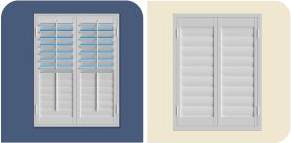
3 Ways Polywood Shutters Are Better Than Hollow Vinyl And Composite Shutters In Boston, MA
December 15, 2015
Plantation shutters in Boston come with different options. And when you want to know which non-wood shutter is best for you, it might be hard to discern the differences. You can easily make the wrong choice and end up investing in shutters that aren’t durable. Are solid polymer shutters, like our best-selling Polywood® shutters, worth more than MDF (multi-density fiberboard) or hollow vinyl shutters? Here are three ways Polywood shutters are preferred over composite shutters in Boston, MA so you can choose.
1. Polywood vs Composite Shutters Durability
Polywood shutters are crafted from a first class solid polymer that results in the most rigidity, color-retention, and durability than any other shutter money can buy. With that, the shutter louvers will not chip as time goes by. On the other hand, composite shutters are built from a pressed-board core, encapsulated in poly-vinyl. The vinyl wrapping the pressed board is prone to peeling from the core element readily. And this peeling is expedited in humid, wet, and hot surroundings. Hollow vinyl shutters are another option for non-wood shutters. But they disintegrate the fastest in large part due to the substance.Both forms of non-wood shutters are susceptible to deterioration and warping under varying weather conditions in Boston. Polywood is made with UV inhibitors that do not absorb heat. And because heat is the main culprit in chipping the shutter louvers, Polywood is without a doubt the longest lasting plantation shutter for your home.
2. Polywood vs Composite Shutters Color Fastness
Polywood shutters come in three premium white paints. The paint finishes are baked on each piece at hot temperatures that exceed any temperatures Boston could experience. The patented finishing process includes UV inhibitors to make sure the color doesn’t fade.
Other types of non-wood shutters are available in no or low quality paint finish. In the majority of cases, the vinyl layer is the final color. Although it looks good when installed, this finish fades as time goes by. And when it comes to hollow vinyls, some are painted. With the vinyl being a heat conductor, this negatively influences the finish day after day.
3. Polywood vs Composite Shutters Energy Efficiency
Third party testing shows that Polywood shutters reduce heat transfer by up to 45% and block up to 30° of temperature. This means that Polywood insulates up to 70% better than a similar solid wood shutter.
It’s the heat blocking properties of the solid polymer material Polywood’s made of that make these plantation shutters so energy efficient. But what sets Polywood apart even more from composite shutters is the weatherstripping on the panels and louvers. All you have to do is interlock the weatherstripping pieces while closing the panels to get a very tight seal against the effects of the weather outside. No matter how far and wide you look, there isn’t a composite shutter that can give you the energy savings close to that of Polywood.
Our Vegas Team Puts The Durability Of Polywood Shutters To The Test
In 2004, Sunburst Shutters Las Vegas had Polywood shutters attached to the sides of their trucks as part of the graphics. The trucks were parked outside and endured the weather Nevada is known for. That means extreme heat for almost five months each year!
The shutters had been on our vehicles for almost 7 years at that point. Our team organized an investigation on how well Polywood retained the color painted on it. We dusted off the Polywood shutter that was on the truck. And we held up a new Polywood shutter next it for comparison. We found the color to be unchanged. There was no fading or discoloration. It was further validation for our team that the Sunburst paint finish is the best in the market!
And with Polywood withstanding all that heat damage travelling on a truck for 7+ years, it’s hands-down the most durable shutter for your house in Boston, MA.


